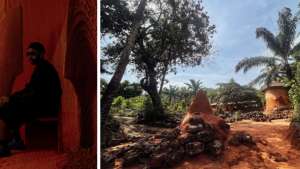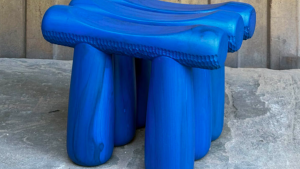A Design Indaba Emerging Creative for 2022, Luke Rudman uses performance art, photography and painting to explore queerness. He does so specifically within the context of the environmental movement, from which queer perspectives have traditionally been absent.
The Gqeberha-based artist – one of 40 young talents making up the Design Indaba Emerging Creatives Class of 2022 – tell us about his processes, influences, and what it means to be a queer body on a planet in the throes of its own destruction.
Tell us about your use of both traditional and non-traditional art forms in your work – and what appeals to you about combining approaches?
I began my journey as an artist through performance and non-traditional modes of artmaking. I only began seriously exploring traditional modes of artmaking years later. Looking back on this progression, I think that this approach helped me unpack notions of traditional and non-traditional artistic modes. I have never felt ‘boxed in’ to a particular medium. I chose to blend the art forms which would result in the most successful and impactful piece of art.
I feel like many of my works have become difficult to categorise into the traditional painting/sculpture/photography/design/performance boxes. Australian artist Leigh Bowery once said, “…if you label me, you negate me.” My approach to artmaking is informed by my own experiences and understanding of the materials I work with rather than a traditional understanding of what these materials ‘should’ be used for. As an artist, I feel more sincere in this approach.
The intersection of environmentalism and a queer aesthetic is intriguing - can you tell us what this means to you, and why the queer body is central to your 'artivism'?
A number of studies over the past decade have revealed that people who identify as queer are significantly more likely to be involved in environmental activism – almost two times as likely as the rest of the population. However, despite this proportionally large number of queer people who feel strongly about climate change and environmentalism, there has been very little representation of queer bodies in environmental campaigns.
When I was first invited to collaborate with Greenpeace in 2019, I created work that drew from the same body of inspiration as usual – I did not want the queerness of my work to be erased just because I was bringing my artmaking into a space that deals with issues of environmentalism. Both topics could – and should – exist within activism simultaneously. Environmentalism needs to be intersectional.
Who inspires your work, and why?
There are so many artists and creatives who inspire me that I will definitely struggle to identify and list all of them. However, some major inspirations, for me, have been Athi-Patra Ruga and Steven Cohen. My initial understanding of art and performance drew heavily on these two icons. Their works are brave and impactful, yet beautiful and skilful.
What are some of the highlights of your career to date?
The most significant highlight of my career to date is more personal than it is professional. The particular form of self-expression and catharsis available to me through my performance work is something that I craved for many years before I began creating it.
I was creating headpieces and experimenting with make-up secretly for a long time, well before I began sharing my work publicly. There was so much shame surrounding the ‘queer aesthetic’ and – at the time – I found myself growing up and developing my sense of self in places that constantly undermined my identity.
I began sharing my performance works in 2017. Today, in 2022, I find myself surrounded by so much more freedom and affirmation. Pushing myself to create a life which is very publicly anchored in my art has been a radical highlight.
What's next for you?
Last year I achieved my undergraduate degree in fine art, cum laude. This year I look forward to continuing my research and artmaking as I begin my postgraduate studies at Nelson Mandela University. I have some really exciting projects, exhibitions and collaborations scheduled over the next few months that I am really looking forward to working on.
Read more:
Announcing Design Indaba’s Emerging Creatives Class of 2022.
#DI Emerging Creative Pule Magopa tells us about how graffiti shaped his artistic career:
#DI Emerging Creative Boitumelo Thindiza on how fashion influences her work:
Credits: Luke Rudman















